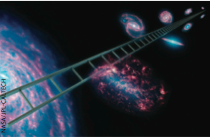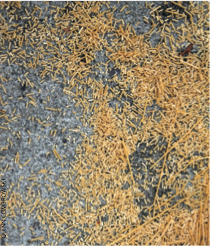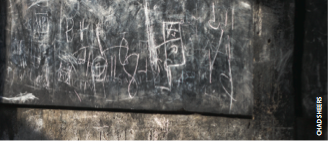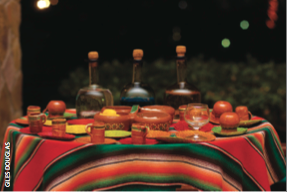MONDAY, 13 OCTOBER 2014
Expansion of the UniverseThe discovery that the Universe is expanding at an accelerating rate won the 2011 Nobel Physics Prize. The recipients had competed for years, Saul Perlmutter leading the Supernova Cosmology Project, and Brian P. Schmidt and Adam G. Riess the High-Z Supernova Research Team.The two groups raced to find Type Ia supernovae, formed from the explosion of white dwarfs. Small areas of sky were repeatedly imaged and carefully searched for tiny changes. Intending to show how the expansion of the Universe was slowing in the wake of the Big Bang, they compared the light curves of the supernovae with others at known distances. Between them, the two groups found 50 distant supernovae whose light was weaker than expected, revealing that the expansion of the Universe is in fact not slowing down, but speeding up.
Snapping spaghetti
The 2006 Ig Nobel for Physics went to Basile Audoly and Sebastien Neukirch for their analysis of high-speed photography to discover why it is impossible to snap dry spaghetti into just two pieces. Spaghetti is flexible but brittle, breaking only when its elastic strain limit is exceeded. When snapped, the two broken ends are released to bend back in the opposite direction. The researchers’ photographs revealed that the rod will, at some points, ping back even further than the original curve. At the site of maximal curvature, it is highly likely to break. So, when a piece of spaghetti is snapped in two, the stress will break off at least one smaller piece.
Tagging proteins with fluorescent markers
The 2008 Nobel Prize in Chemistry was awarded to Osamu Shimomura, Martin Chalfie and Roger Tsien for the discovery and development of green fluorescent protein, or GFP. Osamu Shimomura first isolated GFP from the jellyfish Aequorea victoria, which glows green when agitated. He discovered that the protein would also glow under ultraviolet light. Martin Chalfie then connected the GFP-producing gene to a gene for another protein, tagging the protein with a glowing green colour. This made it possible to track the protein and see which cell populations it inhabited. Roger Tsien further developed the marker by producing a wide colour palette of fluorescing proteins. One exciting use of this technique was the creation of a multi-coloured mouse brain to show how the individual nerve cells are woven together, which could help further our understanding of neurodegenerative diseases.
Human digestive system versus unchewed shrew
Brian Crandall and Peter Stahl were awarded an Ig Nobel prize in 2013 for persuading a volunteer to swallow a parboiled shrew. The rodent was skinned, disembowelled, briefly boiled and cut into three portions which were swallowed by the participant without chewing. For three days afterwards, his faecal matter was collected and examined with a hand lens. Although the skull and jaw sustained some heavy damage from digestive acids, the researchers observed that a considerable number of shrew teeth and bones emerged relatively intact. Their investigation has better enabled archaeologists to draw conclusions about the diets of past societies from mammalian remains.
Stem cells for genetic modification
The 2007 Nobel Prize in Physiology was awarded to Mario Capecchi, Sir Martin Evans and Oliver Smithies, for their work on genetic modifications using embryonic stem cells. Independently, Mario Capecchi and Oliver Smithies demonstrated that genes within a cell can exchange information with each other. This occurs every time an egg is fertilised, when genetic material from two parents is combined into two new chromosomes. Martin Evans applied this finding, observing that if embryonic stem cells were altered, they would pass on that change to all cells which developed from them, regardless of how they specialised. These discoveries have allowed us to introduce gene modifications to whole organisms and examine the roles of individual genes.
Fingernails on a blackboard
Lynn Halpern, Randolph Blake and James Hillenbrand won an Acoustics Ig Nobel prize in 2006 for investigating the unpleasant sound of fingernails scraping on a blackboard. Participants rated the unpleasantness of a recording of a gardening fork scraping across slate. The researchers expected to find that the disagreeable quality was in the high frequencies. However, when they filtered out frequencies above 3 kHz, there was no impact on participants’ ratings. Against expectations, the middle frequencies (2-3 kHz) were found to make the sound unpleasant. The researchers were unable to suggest why this should be the case, but their own repeated exposure to the noise did allow them to report that the experience became more tolerable over time.
Artificial synthesis of medical molecules
A Nobel Prize in Chemistry was awarded to Richard Heck, Ei-ichi Negishi and Akira Suzuki in 2010 for their use of palladium compounds to catalyse cross couplings in organic synthesis. Carbon is the basis for all known life and the development of carbon-based molecules is crucial in medical development. However, carbon is very stable and the atoms do not react easily. Forcing them to join using reactive substances generated unwanted by-products, and isolation from natural sources could never yield sufficient quantities for widespread use. The researchers discovered that palladium compounds could act as catalysts, drawing the carbon atoms together close enough to begin to react. This has enabled the synthesis of carbon molecules that are vitally important in the treatment of conditions including colon cancer, HIV and MRSA.
Five-second rule
Jillian Clarke, a high-school student on a summer internship at the University of Illinois, received a Public Health Ig Nobel in 2004. She investigated the validity of the five-second rule, which claims that dropped food can be safely eaten if it is on the floor for less than five seconds. To simulate the dropping of food on a dirty floor, she inoculated tiles with E. coli and placed food on them. Environmental scanning electron microscopy (SEM) revealed that five seconds was more than sufficient for the bacteria to transfer to the items. But Clarke then swabbed the University floors looking for bacteria. To her surprise, she found very few, probably because floors are too dry for most pathogens. So the five-second rule may be wrong – but you can still eat your dropped food!
Graphene: a super-strong substance peeled off with sticky tape
In 2010, Andre Geim and Konstantin Novoselov were awarded the Nobel Prize for Physics for their groundbreaking experiments with the material graphene, a two-dimensional form of graphite. Graphite comprises many layers of hexagonally- structured carbon. After years of failed attempts to isolate one of these layers, the researchers tried to simply peel them off a graphite block using Scotch tape. Ten to twenty applications of the tape successfully reduced it to a single sheet of atoms. This graphene is stronger than steel, highly stretchable, transparent and a good conductor. Practical applications may include touch screens and flexible electronics smaller than silicon chips. Graphene was not Geim’s first honour for slightly unorthodox research; in 2000, he received an Ig Nobel prize for levitating a frog to demonstrate that water can be levitated in a magnetic field.
Tequila diamonds
In 2009, Javier Morales, Miguel Apátiga and Victor Castaño were honoured with an Ig Nobel Prize for growing diamonds from tequila. They discovered that high-quality diamond films could be produced from ethanol diluted in water. Having determined that the ideal concentration of ethanol was 40%, they repeated the experiment with a $3 bottle of tequila. The tequila was heated to remove impurities and break it down into its constituent parts. The resulting carbon atoms were deposited to form a thin, uniform film which is only visible under an electron microscope. Hard and heat-resistant, this diamond film may provide an alternative to silicon in computer chips and ultra-fine medical cutting instruments.
Sarah Regan is an MPhil student in the Department of Psychiatry






